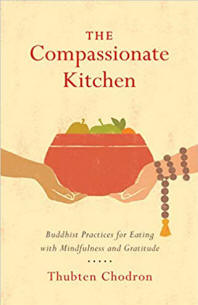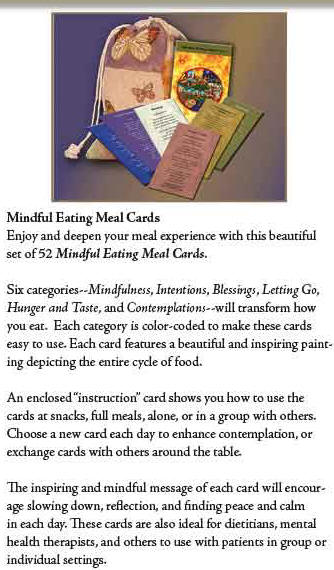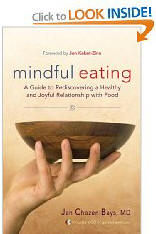Eating Awareness Training
Y Becoming More Aware Of Your Relationship With Food and Life Y
By Bob Wilson BS, DTR

Our body is precious—treat it with care.
When you eat, eat slowly and listen to your body.
Let your stomach tell you when to stop—
NOT your eyes, or your tongue, or your emotions.
Become more aware of your relationship with food. You can increase the satisfaction in your eating by exploring the sensual qualities of foods. Notice WHAT…and HOW you are eating!
Frequently we are lost in thought or distracted with a variety of other activities like reading, watching TV, driving, or talking with others, and we barely notice what or how much we are eating. We may sometimes be surprised that the food is all gone and wonder where it went! Gee, the bag is empty!!! How did that happen? It is because we have developed the habit of not being mindful during our everyday activities. Perhaps explore how aware (or mindful) are you during your other daily activities: Mindfulness and meditation scale.pdf
Also it is important to explore our hungers before we eat. What are we hungry for? What part of us is hungry? As Jan Chozen Bays and Thubten Chodron explores in their book on Mindful Eating (which is in the resources at the end of this article) different kinds of hunger: eye hunger, mouth hunger, stomach hunger, body or cellular hunger, mind hunger, and lastly heart hunger. Upload here: 2019 SACRED EATING WORKSHOP-CHOZEN BAYS.pdf
Also check out this site for Transform Emotional Eating and Addictions.
STEPS involve using all 5 senses:
1. STOP!
2. LOOK!
3. TOUCH IT!
4. SMELL IT!
5. TASTE IT…SLOWLY!
6. LISTEN!
METHOD, WHEREVER POSSIBLE:
Use beautiful settings—make it a CELEBRATION with table settings, place mats, candles, and creative garnishing.
Create a feeling of consciousness, delight and pleasure about your eating! Discover: CELEBRATE Healthful Eating! Yum! Make It FUN. Make It Colorful!

I love using flowers as garnishes. Easter plate shows fruit and low-fat pizza.
1. STOP! Pause. Take three deep breaths. Become quiet. Take a moment to relax. Frequently we use FOOD as a way to calm down or to take a break from our daily routines. This helps reinforce the habit of turning to food for comfort and relaxation (it DOES work!), instead of other more healthful and effective means of calming down and relieving stress.
To help transform this pattern, practice using other ways to calm down. Check out On The Spot Stress Managers and Getting to Know Your Stress and How to Management It.
Step out of the rush of daily activities. Sit down with the food in front of you. Let go of all of the concerns of the day. Ah...
CLOSE YOUR EYES AND RELAX. Take a deep breath and release it.
Be aware of all the numerous people who helped provide you with the contents of the meal, as well as the earth, water and sunshine-- all were necessary for you to have the food. Many elements are interconnected. Cultivate the attitude of thankfulness and awareness about your food choices. Recent scientific research has shown that as you eat, if you focus on pleasant thoughts your digestion slows down and you will feel full on less food!
Check in BEFORE you eat, and FEEL how hungry you are as you're about to eat a meal or a snack. Follow your physical hunger cues instead of your emotional triggers and Emotional Eating.
To notice how sensitive your mouth is...touch your tongue to all parts of your mouth--under the tongue, around the teeth, and on top--of the mouth. Just as our body craves touch, so too does our mouth! This need is called "mouth hunger" and provides psychological satisfaction. Chewing foods and having the food touch all parts of our mouth provides much more satisfaction than does just "drinking our meals," as with liquid meal replacements or beverages. Also, eating adequate amounts of fiber and water also give you a fuller feeling while helping you consume fewer calories (so you can more easily lose weight). This concept is called Eating Large or Volumetrics.
OPEN YOUR EYES and use ALL of your senses...to celebrate the GIFT of food!
2. LOOK! at the food. REALLY observe it. What does it LOOK like? Shapes? Colors? Kinds of foods? The table setting? Do you have any memories of having this food in the past? Do you find your mind filled with thoughts of anticipation or repulsion? Just notice your automatic reactions.
3. SMELL IT! Pick up the plate of food. Smell it—notice the aromas (up to 90 % of taste is smell). Just savor the smell of the foods. Recall the aromas of fresh-baked bread, Italian, or Mexican foods. Remember back to a time when you had a cold and couldn't taste the foods. You might as well been eating sawdust because you can't taste it anyway!
4. TOUCH IT! Caress the food with your finger tips. What textures (smooth, sticky, hard?) , temperatures (hot, warm, or cold), or resistance do you notice?
5. TASTE IT! (Slowly!) Allow it to touch the taste receptors of the tongue. Be conscious of textures, flavors, temperatures. Roll the food around on your tongue. Is the food primarily sweet, sour, salty, bitter? Is the texture smooth, rough, chewy, liquidy?
Practice allowing 30 seconds between bites of food. Put the fork, spoon, or sandwich down between bites!!!
Remember, the ONLY place you can taste foods is in your mouth! Why be in a hurry to get to the next bite?
The NEXT bite won't taste any better than the bite that is in your mouth right now!
6. LISTEN TO IT! What sounds do you hear as you are chewing? Crunchy, noisy, and loud? Or squishy, more soft, and muted?
Savor all of the pleasures that the eating experience brings to you! Doing this helps you feel psychologically satisfied and nurtured.
WITH EACH MOUTHFUL, HAVE A CONSCIOUS THOUGHT:
Gently remember,
1. This is material (building materials) that is used to fuel up your AMAZING machine-- your body-- for a 24-hour period. Food IS a "delicious nutrient" NOT a lover!
2. Enjoy the taste. Celebrate the diversity of flavors—Yum, YUM!
3. Chew slowly. Do you like to eat? Do you enjoy the taste of food? The ONLY place you can enjoy food is in your MOUTH!
4. Pause to enjoy some water to drink. This will help you feel more satisfied.
5. NOTICE when you start to feel satisfied and STOP EATING! During your meal, pause frequently to observe the signals that you are getting full. Remember, It’s NOT your last meal. You will be able to eat again!
6. Observe the impact of the foods and beverages you eat on how your body feels. As you eat discern: Do you begin to feel lethargic, numbed, and tired, OR, do you feel satisfied, energetic, alert, and ready to live life fully? Notice how each food makes your body feel.
7. SAY GOOD-BYE TO ANY REMAINING FOOD! I know that I had all of you coming to me, but I'm satisfied now. Notice if you feel yourself grieving over having to leave some food on your plate. Gee, the food was SO good! Be aware of the DESIRE that arises in you for...more!
Perhaps remember back to a potluck you attended when you went through the food line, ate samples of many delicious foods, and found you were satisfied. Then someone arrived bringing one of your favorite foods! Did you feel a tinge of sadness? "Gee, I sure wish that I could have some! So much food, so little time!" Do you ever find yourself fantasizing about what kinds of foods might be available at a social event that you're going to attend? It's almost like your true FOCUS is on "the food," NOT "the people" who will be there!!! "Oh, this person makes WONDERFUL desserts or casseroles....." Go there to see the people, not the food!
I suggest practicing this process with a snack (like an apple, orange, or pear) at least a couple of times each week. Following this process will help you be more aware (mindful of) your eating behaviors. Repeating this method will help you slow down your eating speed and you will consume LESS food! You will also experience greater pleasure with each of the foods that you do eat! Bon apetit!
I practice this every day with my breakfast meal. I eat a small bowl of cottage cheese with cut-up fresh fruit, a piece of whole wheat, cinnamon, walnut-raisin toast, and a cup of coffee. I eat it SO slowly that it may take me 45 minutes to eat it. Many times I find that I'm filled up and save the remaining food for later. During the day I am then much more attentive to my relationship with food and tend to eat less mindlessly.
Other Suggestions To Help You Eat Less
1. At the table, start leaving a little bit of food on your dish, even one bite (1 tsp.), until you learn that your stomach, NOT the empty plate, ought to be the signal to stop eating.
2. PAUSE and look at the food with authority. ASK, “Do I really want to eat this? What is my body going to do with it? Can it nourish me and promote good health? Do I want to eat this only because it looks pretty? If that is the reason, then I had better enjoy just LOOKING at it and not hide it out of sight in my stomach!” Consider it’s just a work of art!
3. Swallow the food that is in your mouth before you load up the fork again! Don’t rush—how can the next bite, or second helping, give you any more pleasure than the one you’re eating now?
4. Chew thoroughly and slowly. Up to 20 times—there is no hurry! It takes 20 minutes for your body to notify your mind that you are full...that you have consumed enough body fuel.
5. Put the fork or spoon, etc. down between bites.
6. Put the sandwich DOWN between bites! No one is going to STEAL it!
7. Pay attention to taste. Enjoy it! Give thanks for it. WHAT YOU EAT BECOMES YOU!
8. Use smaller glasses, plates, and bowls—it makes the food portions APPEAR larger.
9. Eat a salad or vegetables first—make it a large serving. This helps fill you up.
10. Check out the Factors That Influence How Much We Eat section.
Savor your food. BE CONSCIOUS of every bite. Often eating a meal in less than twenty minutes, or a snack in less than ten minutes, is too fast. Listen to your body. When you are satisfied, stop eating.
REMEMBER, IT’S NOT YOUR LAST MEAL.
YOU WILL BE ABLE TO EAT AGAIN!
See also: The Grace Of Eating: The Five Contemplations Before Meals
Additional Resources
The CAMP System is a new, powerful and different approach to finding balance with food and eating. Named for its components—Control, Attitudes, Mindful Eating and Portions—CAMP is a way of eating that emphasizes how you eat, not what you eat. If you are unhappy with your present relationship to food, the CAMP System could be your lasting solution. Visit http://www.mindfuleating.net/ There you will learn many strategies and techniques to bring mindfulness to your eating every day!
Mindful Meals: Re-learning how to eat with pleasure http://www.bodypositive.com/mindful.htm
Intuitive Eating by Evelyn Tribole M.S. , R.D. and Elyse Resch M.S., R.D. is an excellent resource on honoring your hunger, enjoying the pleasures of food and feeling your fullness. To explore her 10 Principles of Intuitive Eating and her website.
From Amazon
This terrific book explores the 7 types of hunger and how to develop an healthy relationship with food. It includes a audio CD with many excellent guided practice sessions. Sacred Eating at Great Vow: http://www.zendust.org/
Also available from Great Vow Monastery http://zendust.org/zenworks/ If you are ever in Oregon you could visit the monastery for a Sacred Eating workshop (Friday pm-until Sunday) that is excellent. 2019 SACRED EATING WORKSHOP-CHOZEN BAYS.pdf
Explore the principles for mindful living & eating. It is a wonderful summary of the principles that I share on this Website: Principles of mindful eating, one page handout.pdf The Center for Mindful Eating www.TCME.org (mainly for the professional) Patient and Family Newsletters: This one page handout is an ideal introduction to Mindful Eating and can be easily printed as a handout. Patient Newsletter (PDF, 300kb) Family Newsletter (PDF, 116kb)

The Compassionate Kitchen: Buddhist Practices for Eating with Mindfulness and Gratitude Paperback
Every aspect of our daily activities can be a part of spiritual
practice if done with compassion—and this compact guide offers wisdom from the
Buddhist tradition on how eating mindfully can nourish the mind as well as the
body.
Thubten Chodron, abbess of Sravasti Abbey in Washington state,
shows us that eating and activities related to it—preparation of food, offering
and consuming it, and cleaning up afterward—can contribute to awakening and to
increased kindness and care toward others.
Chodron offers traditional Buddhist teachings and specific practices used at the Abbey, along with advice for taking the principles into our own home in order to make the sharing of food a spiritual intention for anyone. By eating consciously and mindfully—and by including certain rituals—we find ourselves less obsessive about food and can enjoy our meals more. To buy it: https://www.shambhala.com/compassionate-kitchen.html
 Explore Mindful Practices for Living by Donald
Altman:
Explore Mindful Practices for Living by Donald
Altman:
Meal by Meal: 365 Daily Meditations for Finding Balance
through Mindful Eating and his Website:
http://www.mindfulpractices.com/
Another superb
resource on slowing down and SAVORING YOUR LIFE
is Peace Is
Every Step- The Path of Mindfulness in Everyday Life, (1991), Bantam Books,
New York, by Thich Nhat Hanh, (1998), Broadway Books All of his books touch the
heart with insight, tenderness, kindness, and practical transformational ideas.
